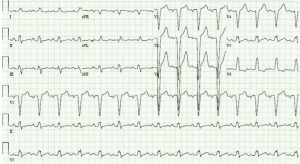Welcome to your #PLAB#InM
A 66 year old man presents to the hospital with palpitations. An ECG taken shows atrial fibrillation. He has no history of any ischaemic heart diseases. His blood pressure is 110/70 mmHg, heart rate is 130 beats/minute and respiratory rate is 20 breaths/minute. He looks sweaty on examination. His chest is clear clinically on auscultation. What is the SINGLE most approprite management?
A 55 year old man has sudden onset of central chest pain and shortness of breath 3 hours ago. He looks pale and sweaty. An ECG was done in the Emergency Department and is seen below:

What is the SINGLE most likely diagnosis based on this ECG?

Which of the following may cause the abnormalities of the QRS axis shown on this ECG?
A 60 year old man had a myocardial infarction 2 weeks ago. He now presents with dyspnoea and pleuritic chest pain. A pericardial friction rub was noticed on examination. ECG shows widespread ST elevation. A chest x-ray shows an enlarged, globular heart. His pulse rate is 95 beats/minute and his respiratory rate is 24 breaths/minute. What is the SINGLE most likely cause of his symptoms?
Q-5 A 62 year old man has a routine ECG pre- operatively for an elective osteoarthritic knee replacement. He is in sinus rhythm, and the WRS complex is not prolonged. There is a gradual prolongation of the PR interval, followed by a dropped beat every 3 or 4 QRS complexes. The ECG machine is unable to calculate the PR interval. The patient does not complain of any palpitations. What is the SINGLE most likely diagnosis?
A 68 year old woman is brought into the Emergency Department with palpitations and chest discomfort. She gives a history of left hemiparesis four days ago which has partially resolved after a few hours. She has a blood pressure of 160/95 mmHg, respiratory rate of 22 breaths/minute and a heart rate of 120 beats/minute. A CT scan of the head was organised which shows evidence of a small cortical infarct. An ECG taken in the Emergency Department shows absent P waves and an irregularly irregular rhythm with a variable ventricular rate. Metoprolol was given intravenously and she was discharged once asymptomatic. Which long term medications is she likely to benefit from?
A 45 year old lady who was previously fit and well is admitted with breathlessness, palpitations and a history of two episodes of syncope over the past two days. Upon further questioning, she admits to having difficulty breathing when she sits upright. She finds great relief when she lies down flat on her couch. Upon examination, the tips of her fingers are noted to be blue and clubbing is noticed. Auscultation reveals a mid-diastolic rumble which changes when the patient changes position and a loud S1 at the cardiac apex. What is the SINGLE most likely diagnosis?
A 75 year old man is found to be unresponsive. The ward doctor is called to the patient's bedside. He is not breathing and has no detectable pulse. Which is the SINGLE most appropriate next step?





